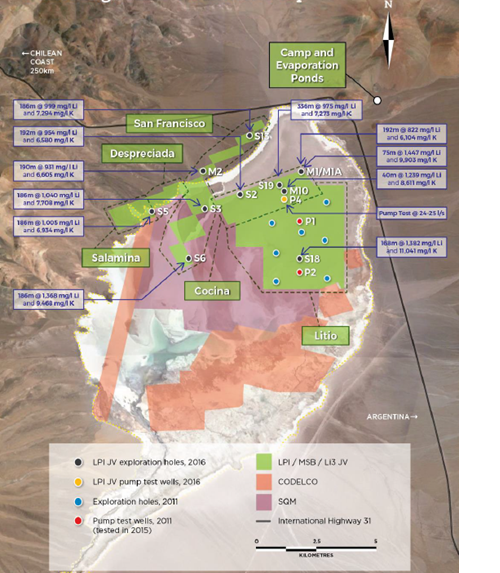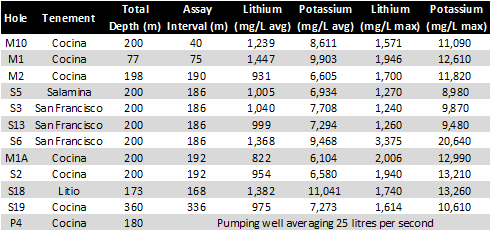
Vancouver, British Columbia - Bearing Resources Ltd. ("Bearing" or the "Company") (TSX Venture: BRZ) (OTCQB: BRGRF) (FRANKFURT: B6K1) has received results from Li3 Energy Inc (“Li3”) from the ongoing exploration program at the Maricunga lithium brine project located in Chile (the “Maricunga Project”). Bearing has entered into a definitive agreement to acquire Li3 and its interest in the Maricunga lithium brine project (the “Li3 Definitive Agreement”). Li3 holds a 17.7% interest in the project along with Minera Salar Blanco (“MSB”) and Lithium Power International Limited (“Lithium Power”) at 32.3% and 50% respectively. Under the terms of the joint venture, Lithium Power has agreed to fund exploration and development costs with both Li3 and MSB having a free carry until the completion of a definitive feasibility study.
Exploration Results
Assay results were released for three holes, two of which were drilled on the “old code” Cocina tenement and one on the Litio tenement. Results were initially released by Lithium Power on February 15th, 2017 (Australia). Highlights of drilling include the deep hole S19, drilled to a depth of 360 metres on the Cocina tenement, which averaged 975 mg/l lithium over a 336-metre interval with a peak assay of 1,614 mg/l lithium. Hole S19 represents the deepest hole drilled on the project to date, compared to the majority of holes from the current exploration program that were drilled to around 200 metres, with high-grade lithium bearing sands present at the end of the hole. All holes from the current phase of the exploration program have now been released and will form the basis of a resource estimate which is anticipated in Q2/17.
Cocina (2 holes) – Rotary drill hole S19 was drilled to a depth of 360 metres with the objective of testing the potential of the lithium-bearing sands encountered in drilling of the upper 200 metres at depth. Sample assays returned an average grade of 975 mg/l lithium and 7,273 mg/l potassium over the 336-metre sample interval (from 18 metres to 354 metres) with a peak of 1,614 mg/l lithium and 10,610 mg/l potassium over a 6-metre sample at 18 metres depth. The hole terminated in high-grade lithium bearing sands at depth with assays of 877 mg/l lithium and 6,910 mg/l potassium over a 6-metre sample at a depth of 354 metres. Sonic drill hole S2 was drilled to a depth of 200 metres, averaging 954 mg/l lithium and 6,580 mg/l potassium over the 192-metre sample interval (from 5 metres to 197 metres) with a peak of 1,940 mg/l lithium and 13,210 mg/l potassium over a 6-metre sample at 5 metres depth.
Litio (1 hole) – Sonic drill hole S18 was drilled to a depth of 173 metres and averaged 1,382 mg/l lithium and 11,041 mg/l potassium over a 168-metre sample interval (from 5 metres to 173 metres) with a peak assay of 1,740 mg/l lithium and 13,260 mg/l potassium over a 6-metre sample at 65 metres depth.
Figure 1: Maricunga Tenement Map Annotated with Drill Results

Source: Lithium Power International
Figure 2: Phase I Exploration Program Summary

Source: Lithium Power International
Jeremy Poirier, President and Chief Executive Officer of the Company commented: “We are extremely pleased with the results from the current phase of drilling on the Maricunga project. Firstly, all holes have intersected and terminated in high-grade brine at depths below historical drilling. Secondly, the results from the deep exploration hole demonstrates the potential for future resource delineation to depths of 360 metres and beyond. Overall, we believe the project has the potential to host a significant lithium and potassium resource with opportunities for further growth both laterally and at depth.”
QA/QC:
Drilling of hole S19 was by rotary drilling that provides cuttings for lithological logging and for geological interpretation.Sonic drilling of hole S2 and S18 produced cores with close to 100% core recovery. This technique uses sonic vibration to penetrate the salt lake sediments. Brine samples were collected at 6 m intervals during drilling. This involved purging brine from the drill hole and then taking a sample corresponding to the interval between the rods and the bottom of the hole.The brine sample was collected in a clean plastic bottle and filled to the top to minimize air space within the bottle. Brine samples collected following the purging of the holes are homogenized as brine is extracted from the hole using a bailer device.Each bottle was taped and marked with the sample number and details of the hole and the time of the sample were noted.The University of Antofagasta in northern Chile was used as the primary laboratory to conduct the assaying of the brine samples collected as part of the drilling program. They also analyzed blanks, duplicates and standards, with blind control samples in the analysis chain.Additional details of the QA/QC program and sampling procedures are provided in the Lithium Power press releases mentioned.
Robert Cameron, P.Geo., who is a technical consultant to the Company and is a qualified person within the context of National Instrument 43-101, has read and takes responsibility for this news release.
ON BEHALF OF THE BOARD
Signed "Jeremy Poirier"
Jeremy Poirier, Director President and CEO
FOR FURTHER INFORMATION PLEASE CONTACT:
Jeremy Poirier | Director President & CEO
Phone: + 1 604 262 8835
Email: [email protected]
![]()
Neither the TSX Venture Exchange nor its Regulation Services Provider (as that term is defined in the policies of the TSX Venture Exchange) accepts responsibility for the adequacy or accuracy of this release.
About Bearing Resources Ltd.
Bearing is an exploration and development company. The Li3 Definitive Agreement will enable it to acquire an interest in the advanced-stage Maricunga project located in Chile, which represents one of the highest-grade development opportunities in the Americas. Assuming completion of the transactions contemplated by the Agreement, Bearing will have an undivided 17.7% interest in the project with all expenditures through to the delivery of a Definitive Feasibility Study (DFS) fully-funded by its joint-venture partners. The Maricunga Project has had in excess of US$25 million of exploration to date.